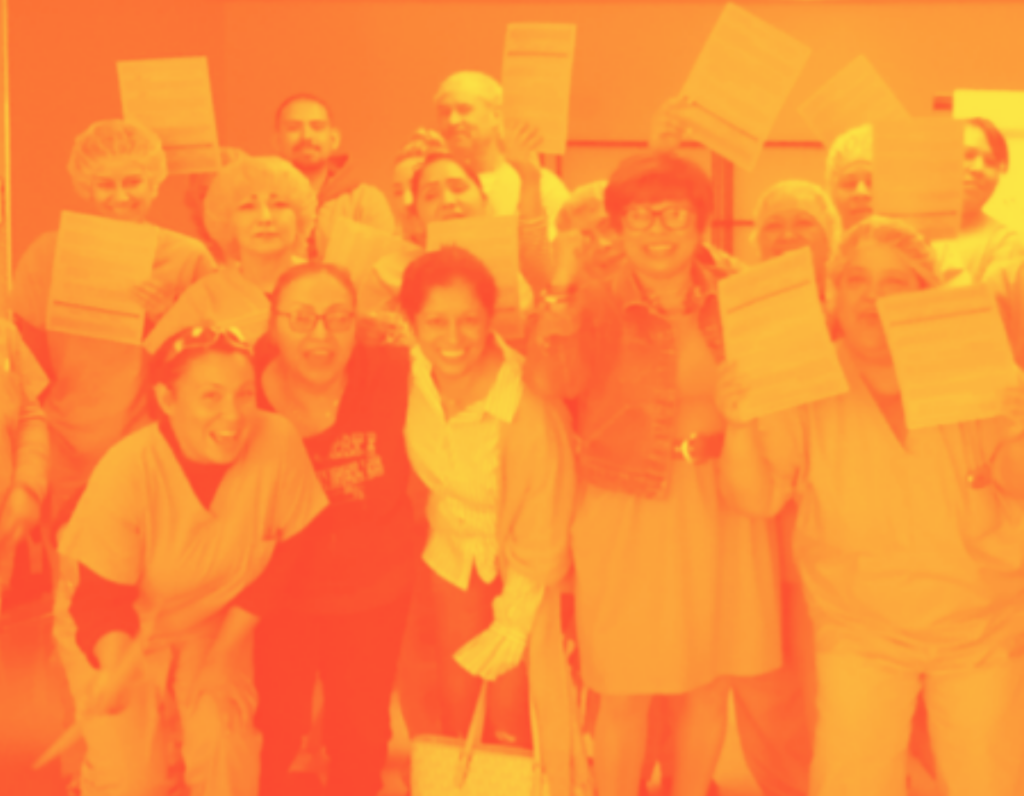Once in a while a book comes along that makes you feel the hard-won solidarity of a union organizing campaign and what it takes to build it. Daisy Pitkin’s On the Line: A Story of Class, Solidarity, and Two Women’s Epic Fight to Build a Union is such a book. It’s a vivid and gripping memoir about her experiences as an organizer working with industrial laundry workers in Phoenix in the 2000s.
Pitkin and I were both working for the union UNITE (Union of Needletrades, Industrial and Textile Employees) at the time, although I didn’t work on this campaign. Having worked for unions for more than 20 years as an organizer, researcher, and campaigner, I know just how hard the work of organizing is. But it can also be exhilarating when you build solidarity and win. I had my first taste of this in graduate school as a member and president of my union, the Graduate Employees Organization, in the late 1990s.
I looked forward to reading Pitkin’s book with excitement because I love organizing stories. But I also had some dread, because it includes a painful account of the UNITE HERE civil war that brought up memories I would prefer to leave behind.
How to organize
On the Line, written as a series of letters to laundry worker Alma Gomez García, takes us through the drama of running a union organizing campaign. The book focuses on the 200 immigrant Latinx workers at a large laundry run by Sodexo that cleaned linens for Phoenix area hospitals. We learn about the harsh working conditions along with Pitkin, as she talks with the workers about the fast, heavy, repetitive labor, which often leads to injuries. García had worked at the laundry for about a decade, and she becomes an early worker leader in the campaign. We hear about her job in the “soil sort” department.
“This is when you stood to demonstrate – the belt moves in front, you said, standing but leaning down a bit, miming the motion of the conveyor with both hands. The speed at which your hands moved surprised me. That fast I asked, and you nodded and hardened the S on Si for emphasis. You demonstrated how the person working in that first position picks sheets up off the automated belt, hands not moving in tandem but opposite each other, doubling the pace of movement and, I supposed, the number of sheets that it is possible to throw in a given stretch of time. You gestured that the sheets are thrown across the belt to bins on the other side. I tried to imagine doing this for an eight- or ten-hour shift…You were animated, energetic, even “fired up,” as I wrote in my notebook when Manuel and I got back to the car. But you must have been tired, too.”
Pitkin brings us into the life of the campaign, with its twists and turns over several years, and its ultimate victory. The conversations with workers, building worker lists and charts, following delivery trucks, assessing and reassessing everything, planning and taking actions, the endless meetings. She talks about how they built power over time.
“It was built, piece by piece, through the everyday tasks and exchanges that comprised our organizing. We made leaflet copies at Kinko’s. We drove in circles around the city. We packed and unpacked the folding chairs for our committee meetings. We knocked on thousands of doors. We asked people to trust us, and they did. We stood together in the parking lot, running department meetings from midnight until 4 a.m., and listened as the moths plinked their bodies against the floodlights.”
This is the painstaking process of helping workers build more trust and solidarity with each other, and the confidence to fight through a tough union election campaign against inevitable employer union-busting. This fight can also forge deep bonds between the union organizers and the workers, as it did with Pitkin and García.
Moths to a flame
And about those moths. Pitkin’s chapters are alternately titled Las Polillas (the moths) and Fire. Moths were flying all around Phoenix during the campaign, and they invaded Pitkin’s dreams as well. Pitkin’s study of moths provides a break from the campaign action, though there are labor issues there too, as when she discusses a French women’s silk workers strike.

Fire is a central element in UNITE history. It’s foundational to the early history of its predecessor union, the International Ladies Garment Workers Union (ILGWU), when the infamous 1911 Triangle Shirtwaist Factory fire killed 146 workers. Pitkin skillfully weaves the history of the union and an early leader, Clara Lemlich, throughout the book.
The Moth and Fire are in an extended metaphor. Do the moths represent workers, endlessly circling a flame? Are they Pitkin and García driving in circles around Phoenix, visiting workers? Does the flame represent the solidarity and power they are trying to build, or the real risks in forming a union? We want the flame, but if we reach it, will we get burned?
Staff and workers
Pitkin thoughtfully raises the tricky relationship that exists between staff organizers and the workers. Workers can always organize organically on their own, and some do, taking actions, going on strike, and sometimes winning improvements. But getting through a tough union election and bargaining a contract, amidst tremendous employer opposition, almost always involves working with an established union and its organizers. The Sodexo union busting campaign was serious enough to be featured in a 2010 Human Rights Watch report.
Pitkin was living in a hotel for years during most of this campaign, and other staff flew in and out as needed, especially for the UNITE-style “blitz” weekends, where the union tried to visit all the workers before filing for an election. This UNITE organizing methodology is common among unions, and it assumes workers need this intense help, and often they do. But Pitkin asks who is building the power here, and what kind of union are we creating?
I also appreciated Pitkin’s critical thoughts on the ways this organizing is sometimes subsumed, and possibly undermined, by larger “corporate campaigns.” These campaigns publicly raise issues of corporate violations and other bad practices to try to get broad agreements from companies on “card check neutrality.” Workers can then organize more easily and not have to slog through years of fighting management at each workplace. I was trained in this framework in my time at UNITE, and it can be useful and effective. These strategies have arisen as a way to deal with the absolute inadequacy of labor law, where workers can be fired for organizing with little consequences.
But Pitkin’s experiences provide a cautionary tale of the impact these agreements can have on the ground when major decisions about which workers can organize, and around what issues, are hammered out elsewhere. In Pitkin’s telling, the final largely “prefabricated” contract reached at Sodexo, while including some real improvements, was somewhat lackluster. The “hollowness of the performance” of the contract campaign and bargaining was clear enough to the workers. Yet it was a start, and getting a contract in this difficult campaign was a tremendous achievement. I hope the union there has gained strength and won better conditions over time. The laundry has since been purchased by Crothall and the current contract is here.
In these campaigns, the workers can feel caught in the middle of a large fight between the union and the employer, rather than like active agents of change in their own workplace. There is a real danger of their experiencing the union as the “third party” that union-busters call it, where the union is seen as an organization separate from the workers. Along with Pitkin, I want to be self-critical, and my own experience has convinced me that “top down” corporate campaigning on behalf of workers will not create the larger, reinvigorated, more militant labor movement we need. We know workers have to be central to the process of their own empowerment.
Pitkin says in an interview about the book that union staff are rethinking their roles, and she believes that “whatever experience and expertise I have needs to be democratized immediately…it’s about democratizing the knowledge and expertise held by staff inside the union and then getting out of the way.”
Things fall apart
The last part of the book details Pitkin’s experiences during the intense conflict that developed within UNITE HERE. UNITE had merged with the Hotel Employees and Restaurant Employees Union (HERE) in 2004 to form UNITE HERE. Five years later, a leadership struggle plunged the union into a nasty divorce. The events of this fight have been covered previously in news articles and in a chapter in Steve Early’s The Civil Wars in U.S. Labor. But Pitkin’s may be the only extended first-person account of this conflict I have ever seen. This is difficult reading.
The divorce was final when most of the UNITE side broke away and formed Workers United, which merged with the Service Employees International Union (SEIU) in 2009. Both Pitkin and I ended up with Workers United for a while, and she has returned there. It’s heartbreaking to look back now at how much union time and resources went into a conflict that would ultimately harm the workers the most. This fight ultimately broke the friendship between Pitkin and García.
Hope and care
On the Line is a must read for anyone interested in the messy details and politics of union organizing in real-world campaigns. It also raises good questions about how and why we do this work. Pitkin thinks a lot about solidarity and what enables workers to fight.
“…I was taught – and so I believed – that anger is the primary emotion that drives people to fight, the only emotion strong enough to overcome fear. And anger is powerful, it’s true, but care for one another is too. And care for one another, unlike anger (or unlike anger for me), is continually renewable – it becomes both an engine for the fight and a destination for it, elemental to the new world the fight demands…Care for one another functions this way mainly because it allows for hope, which is the substance of solidarity.”
Solidarity as a “mixture of hope and care,” as Pitkin also says, and maybe with some anger thrown in as well: The ultimate question for everyone in the labor movement is how unions can help many more workers build this kind of solidarity and power. Pitkin provides us with a lot to think about.
On the Line: A Story of Class, Solidarity, and Two Women’s Epic Fight to Build a Union, by Daisy Pitkin. Workman Press, 2022
Featured image: Laundry-worker members of Workers United, Western Regional Joint Board, SEIU.
Did you enjoy this article?
We're in the middle of our annual fund drive, and this year we're building our own internal infrastructure for subscriptions, meaning more of every dollar pledged goes to fulfilling our mission. Subscribe today to support our work and be a part of Convergence's next evolution.

